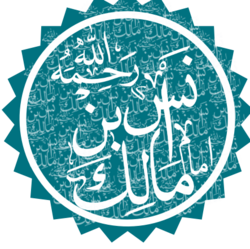Anas ibn Malik
Anas ibn Malik أنس بن مالك | |
|---|---|
 Calligraphic representation of Anas ibn Malik's name | |
| Born | 611 or 612 |
| Died | 712 CE (93 AH) |
| Burial place | Basra |
| Other names | ibn Malik |
| Known for |
|
| Parents |
|
| Relatives | Abdullah ibn Abi Talha (step-brother) Abu Talha al-Ansari (step-father) |
| Family | Najjar clan of the Banu Khazraj tribe |
Anas ibn Malik ibn Nadr al-Khazraji Al-Ansari (Arabic: أنس بن مالك الخزرجي الأنصاري (c.612 – c.712[1]) was a well-known sahabi (companion) of the Prophet of Islam.
Hadith of Anas[]
Within collection 4 (Ablution)[2] of the Persian Islamic scholar, Muhammad Bukhari (d.870) , Companion Anas was the source of The Ḥadith of Camel Urine.[3][4]
Bukhari also narrated a version of this Hadith, without the mention of "urine":
- Narrated Anas Ibn Malik: Some people were sick and they said, "O Allah's Messenger (ﷺ)! Give us shelter and food. So when they became healthy they said, "The weather of Medina is not suitable for us." So he sent them to Al-Harra with some she-camels of his and said, "Drink of their milk."
- (Sahih Bukhari, 5685) [5]
Biography[]


Anas ibn Malik, a member of the Najjar clan of the Khazraj tribe of Yathrib, was born ten years before the Prophet Muhammad's Hijrah. After his father, , died a non-Muslim, his mother, Umm Sulaim, remarried to a new convert, Abu Talha ibn Thabit. Anas's half-brother from this marriage was Abdullah ibn Abi Talha.[6]
When the prophet arrived in Medina in 622, Anas's mother presented him to the prophet as a servant to him.[1]
After the prophet's death in 632, Anas participated in the wars of conquest.[1] He was the last of the prominent Companions of the Prophet to die. Anas died in 93 AH (712 CE)[7] in Basra[8] at the age of 103 (lunar) years.[8]
Shrine[]
The shrine of Anas Ibn Malik is claimed to be located in Basra, Iraq.[9] The grave of Anas Ibn Malik is a simple cenotaph. However, the shrine was destroyed with explosive devices. Despite the fact that the mosque and shrine is heavily damaged and walls stained with vandalism, the complex is still a popular place of visit by Sunni Muslims.[citation needed]
See also[]
- Sunni view of the Sahaba
- Anas ibn Nadhar
Notes[]
- ^ Jump up to: a b c Finding the Truth in Judging the Companions, 1. 84-5; EI2, 1. 482 A. J. Wensinck J. Robson
- ^ USC-MSA
- ^ David Waines. Milk, Encyclopedia of the Quran
- ^ Book 4 (ablutions) of Sahih al-Bukhari
- ^ Bukhari 76:8
- ^ Biography of Rumaysa bint Milhan - Mother of Anas bin Malik Archived 2009-05-27 at archive.today at Compendium of Muslim Texts
- ^ "سير أعلام النبلاء » ومن صغار الصحابة » أنس بن مالك". Retrieved 15 October 2013.
- ^ Jump up to: a b T. P. Hughes, 1885/1999, Dictionary of Islam, New Delhi: Rupa & Co.
- ^ "Iraqi Boys Disrespect Anas Ibn Malik (RA)'s Grave by Standing on It".
External links[]
- 612 births
- 709 deaths
- Sahabah hadith narrators
- Khazrajite people